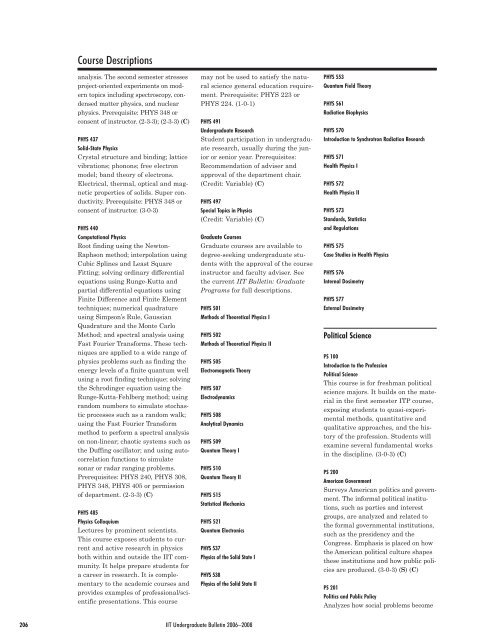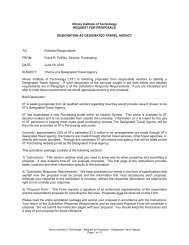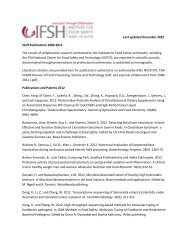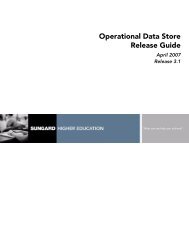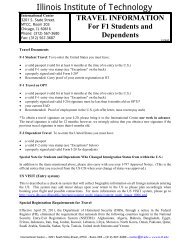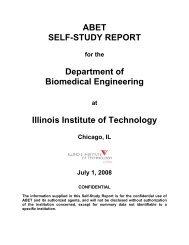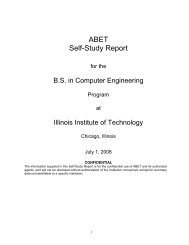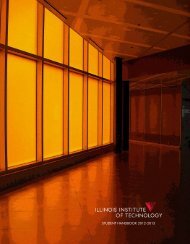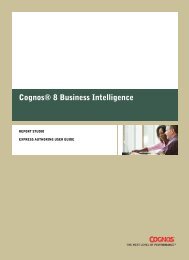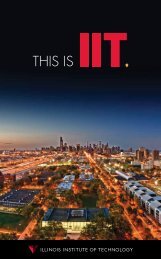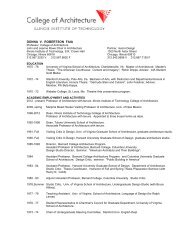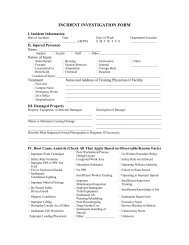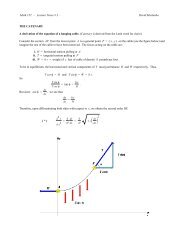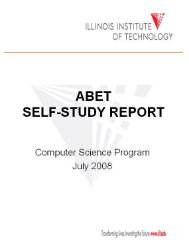Copyright & Disclaimer Information - Illinois Institute of Technology
Copyright & Disclaimer Information - Illinois Institute of Technology
Copyright & Disclaimer Information - Illinois Institute of Technology
You also want an ePaper? Increase the reach of your titles
YUMPU automatically turns print PDFs into web optimized ePapers that Google loves.
206<br />
Course Descriptions<br />
analysis. The second semester stresses<br />
project-oriented experiments on modern<br />
topics including spectroscopy, condensed<br />
matter physics, and nuclear<br />
physics. Prerequisite: PHYS 348 or<br />
consent <strong>of</strong> instructor. (2-3-3); (2-3-3) (C)<br />
PHYS 437<br />
Solid-State Physics<br />
Crystal structure and binding; lattice<br />
vibrations; phonons; free electron<br />
model; band theory <strong>of</strong> electrons.<br />
Electrical, thermal, optical and magnetic<br />
properties <strong>of</strong> solids. Super conductivity.<br />
Prerequisite: PHYS 348 or<br />
consent <strong>of</strong> instructor. (3-0-3)<br />
PHYS 440<br />
Computational Physics<br />
Root finding using the Newton-<br />
Raphson method; interpolation using<br />
Cubic Splines and Least Square<br />
Fitting; solving ordinary differential<br />
equations using Runge-Kutta and<br />
partial differential equations using<br />
Finite Difference and Finite Element<br />
techniques; numerical quadrature<br />
using Simpson’s Rule, Gaussian<br />
Quadrature and the Monte Carlo<br />
Method; and spectral analysis using<br />
Fast Fourier Transforms. These techniques<br />
are applied to a wide range <strong>of</strong><br />
physics problems such as finding the<br />
energy levels <strong>of</strong> a finite quantum well<br />
using a root finding technique; solving<br />
the Schrodinger equation using the<br />
Runge-Kutta-Fehlberg method; using<br />
random numbers to simulate stochastic<br />
processes such as a random walk;<br />
using the Fast Fourier Transform<br />
method to perform a spectral analysis<br />
on non-linear; chaotic systems such as<br />
the Duffing oscillator; and using autocorrelation<br />
functions to simulate<br />
sonar or radar ranging problems.<br />
Prerequisites: PHYS 240, PHYS 308,<br />
PHYS 348, PHYS 405 or permission<br />
<strong>of</strong> department. (2-3-3) (C)<br />
PHYS 485<br />
Physics Colloquium<br />
Lectures by prominent scientists.<br />
This course exposes students to current<br />
and active research in physics<br />
both within and outside the IIT community.<br />
It helps prepare students for<br />
a career in research. It is complementary<br />
to the academic courses and<br />
provides examples <strong>of</strong> pr<strong>of</strong>essional/scientific<br />
presentations. This course<br />
<strong>Copyright</strong> & <strong>Disclaimer</strong> <strong>Information</strong>: <strong>Copyright</strong> © 1994, 1995, 1996, 1997, 1998, 1999, 2000, 2001, 2002, 2003, 2004, 2005, 2006, 2007. CollegeSource®, Inc. and Career Guidance Foundation. CollegeSource® digital catalogs are derivative works owned and copyrighted by CollegeSource®, Inc. and Career Guidance Foundation. Catalog content is owned and copyrighted by the appropriate school. While CollegeSource®, Inc. and Career Guidance Foundation provides information as a service to the public, copyright is retained on all digital catalogs.<br />
<strong>Copyright</strong> & <strong>Disclaimer</strong> <strong>Information</strong>: <strong>Copyright</strong> © 1994, 1995, 1996, 1997, 1998, 1999, 2000, 2001, 2002, 2003, 2004, 2005, 2006, 2007. CollegeSource®, Inc. and Career Guidance Foundation. CollegeSource® digital catalogs are derivative works owned and copyrighted by CollegeSource®, Inc. and Career Guidance Foundation. Catalog content is owned and copyrighted by the appropriate school. While CollegeSource®, Inc. and Career Guidance Foundation provides information as a service to the public, copyright is retained on all digital catalogs.<br />
may not be used to satisfy the natural<br />
science general education requirement.<br />
Prerequisite: PHYS 223 or<br />
PHYS 224. (1-0-1)<br />
PHYS 491<br />
Undergraduate Research<br />
Student participation in undergraduate<br />
research, usually during the junior<br />
or senior year. Prerequisites:<br />
Recommendation <strong>of</strong> adviser and<br />
approval <strong>of</strong> the department chair.<br />
(Credit: Variable) (C)<br />
PHYS 497<br />
Special Topics in Physics<br />
(Credit: Variable) (C)<br />
Graduate Courses<br />
Graduate courses are available to<br />
degree-seeking undergraduate students<br />
with the approval <strong>of</strong> the course<br />
instructor and faculty adviser. See<br />
the current IIT Bulletin: Graduate<br />
Programs for full descriptions.<br />
PHYS 501<br />
Methods <strong>of</strong> Theoretical Physics I<br />
PHYS 502<br />
Methods <strong>of</strong> Theoretical Physics II<br />
PHYS 505<br />
Electromagnetic Theory<br />
PHYS 507<br />
Electrodynamics<br />
PHYS 508<br />
Analytical Dynamics<br />
PHYS 509<br />
Quantum Theory I<br />
PHYS 510<br />
Quantum Theory II<br />
PHYS 515<br />
Statistical Mechanics<br />
PHYS 521<br />
Quantum Electronics<br />
PHYS 537<br />
Physics <strong>of</strong> the Solid State I<br />
PHYS 538<br />
Physics <strong>of</strong> the Solid State II<br />
IIT Undergraduate Bulletin 2006–2008<br />
PHYS 553<br />
Quantum Field Theory<br />
PHYS 561<br />
Radiation Biophysics<br />
PHYS 570<br />
Introduction to Synchrotron Radiation Research<br />
PHYS 571<br />
Health Physics I<br />
PHYS 572<br />
Health Physics II<br />
PHYS 573<br />
Standards, Statistics<br />
and Regulations<br />
PHYS 575<br />
Case Studies in Health Physics<br />
PHYS 576<br />
Internal Dosimetry<br />
PHYS 577<br />
External Dosimetry<br />
Political Science<br />
PS 100<br />
Introduction to the Pr<strong>of</strong>ession<br />
Political Science<br />
This course is for freshman political<br />
science majors. It builds on the material<br />
in the first semester ITP course,<br />
exposing students to quasi-experimental<br />
methods, quantitative and<br />
qualitative approaches, and the history<br />
<strong>of</strong> the pr<strong>of</strong>ession. Students will<br />
examine several fundamental works<br />
in the discipline. (3-0-3) (C)<br />
PS 200<br />
American Government<br />
Surveys American politics and government.<br />
The informal political institutions,<br />
such as parties and interest<br />
groups, are analyzed and related to<br />
the formal governmental institutions,<br />
such as the presidency and the<br />
Congress. Emphasis is placed on how<br />
the American political culture shapes<br />
these institutions and how public policies<br />
are produced. (3-0-3) (S) (C)<br />
PS 201<br />
Politics and Public Policy<br />
Analyzes how social problems become


